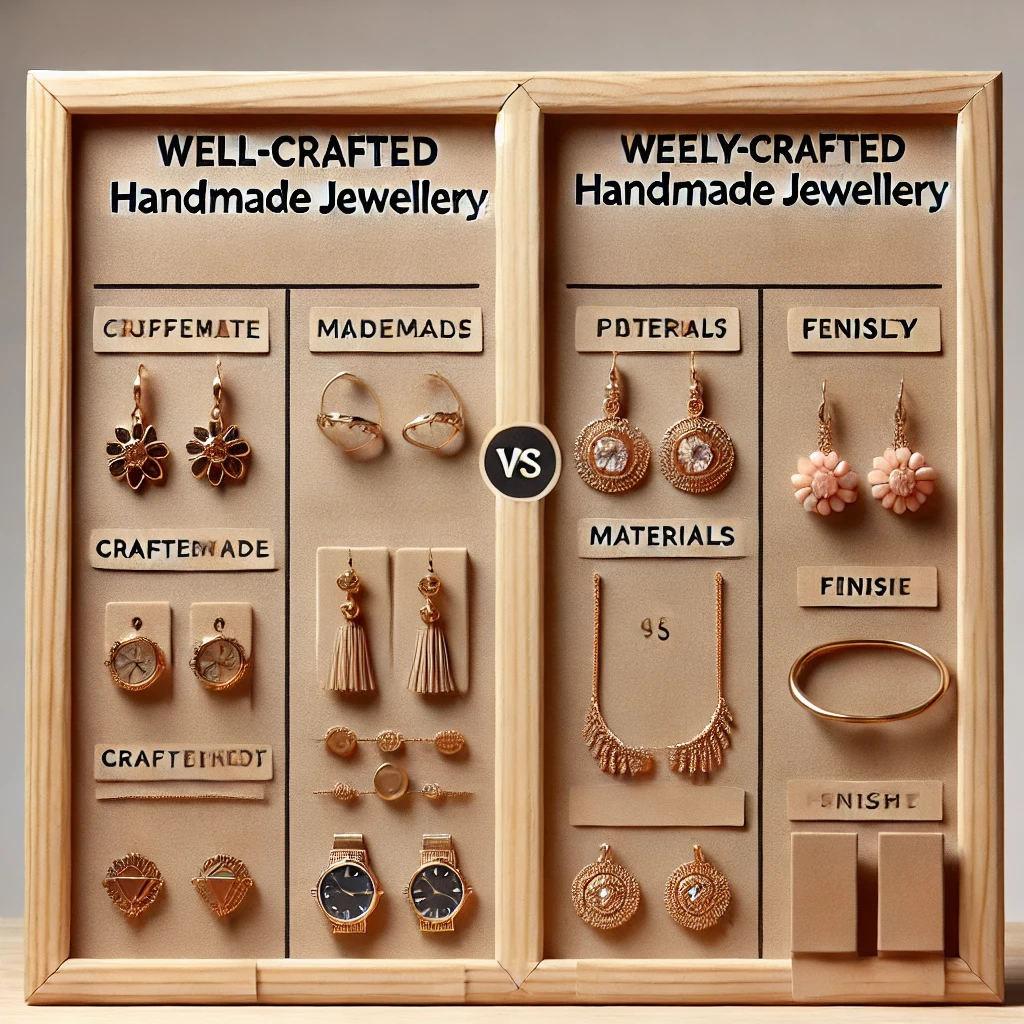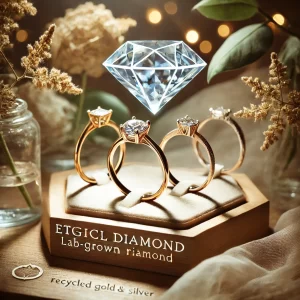Handmade jewellery is a beautiful expression of creativity and craftsmanship, offering unique designs that mass-produced pieces often lack. However, identifying quality jewellery in the world of artisan jewellery requires a discerning eye. With so many options available, understanding the hallmarks of superior craftsmanship can help you make informed decisions and invest in pieces that stand the test of time.
In this guide, we’ll share handmade jewellery tips to help you recognize top-tier craftsmanship, spot quality materials, and appreciate the artistry behind handmade creations. Whether you’re a seasoned collector or a first-time buyer, these insights will empower you to find pieces that are both stunning and enduring.

The Unique Appeal of Handmade Jewellery
Handmade jewellery offers several advantages over machine-made counterparts. Each piece is crafted with care, resulting in one-of-a-kind designs that reflect the artisan’s skill and passion.
Key Benefits of Handmade Jewellery:
- Unique Designs: No two pieces are exactly alike, ensuring exclusivity.
- Personal Connection: Many artisans infuse their work with personal meaning and cultural significance.
- Sustainable Practices: Handmade jewellery often uses eco-friendly materials and processes, reducing environmental impact.
- Support for Artisans: Purchasing handmade jewellery supports local artists and small businesses.
However, to fully enjoy these benefits, it’s important to know how to distinguish well-crafted pieces from those of lesser quality.
How to Evaluate the Quality of Handmade Jewellery
Spotting quality in handmade jewellery involves assessing several factors, from materials to craftsmanship. Here’s what to look for:
1. High-Quality Materials
The choice of materials directly impacts the durability and beauty of handmade jewellery.
- Metals: Look for durable metals like sterling silver, 14K gold, or platinum. Avoid low-quality alloys that can tarnish or irritate the skin.
- Gemstones: Examine gemstones for vibrant color, clarity, and secure settings. Authentic natural stones are more valuable than synthetic or treated alternatives.
- Beads and Accents: Ensure beads, pearls, or other accents are uniform in shape and size, reflecting attention to detail.
2. Craftsmanship
Handmade jewellery should exhibit meticulous craftsmanship, with no signs of rushed or careless work.
- Symmetry: Check for even shapes and consistent patterns.
- Finish: Surfaces should be smooth, polished, and free of scratches or dents.
- Secure Settings: Gemstones should be tightly held in place with no wobbling.
- Joinery: Connections, such as clasps and links, should be sturdy and seamless.
3. Weight and Balance
Quality jewellery often feels substantial without being overly heavy. It should sit comfortably and naturally when worn, reflecting thoughtful design.
Signs of Poor-Quality Handmade Jewellery
Knowing what to avoid is just as important as recognizing excellence. Here are some red flags to watch for:
- Rough Edges: Uneven or sharp edges indicate poor finishing.
- Loose Components: Beads, gemstones, or clasps that move excessively suggest weak construction.
- Tarnish or Discoloration: Low-quality metals may tarnish or lose their finish over time.
- Misaligned Patterns: Designs that lack symmetry or consistency often signal lackluster craftsmanship.
When in doubt, don’t hesitate to ask the artisan about their techniques, materials, and processes. Reputable makers are often happy to share details about their work.
Understanding the Artistry Behind Handmade Jewellery
Handmade jewellery is an art form that requires skill, patience, and creativity. Understanding the techniques used by artisans can deepen your appreciation for their work.
Popular Techniques in Handmade Jewellery:
- Wire Wrapping: Involves wrapping metal wire around gemstones or beads to create intricate designs.
- Hammering: Adds texture and dimension to metal surfaces.
- Casting: Allows artisans to create complex shapes by pouring molten metal into molds.
- Hand Knotting: Common in pearl or bead necklaces, hand knotting ensures durability and elegance.
Each technique reflects the artisan’s expertise and artistic vision, contributing to the piece’s unique character.
The Role of Sustainability in Handmade Jewellery
Many artisans prioritize sustainability, making handmade jewellery an eco-conscious choice.
Eco-Friendly Practices:
- Recycled Metals: Using recycled gold or silver reduces the demand for mining.
- Ethical Gemstones: Sourcing conflict-free and responsibly mined gemstones ensures ethical practices.
- Minimal Waste: Artisans often work with minimal waste, using materials efficiently.
By choosing sustainable handmade jewellery, you can enjoy beautiful pieces while supporting environmentally responsible practices.
How to Shop for Quality Handmade Jewellery
Buying handmade jewellery can be a rewarding experience if you know where to look and what questions to ask.
1. Shop from Reputable Artisans
Look for artisans with a strong reputation, positive reviews, and clear policies on returns and guarantees. Visit craft fairs, artisan markets, or reputable online platforms that showcase handmade work.
2. Ask Questions
Don’t hesitate to ask the artisan about their materials, techniques, and inspiration. Genuine creators are often eager to share their process and passion.
3. Request Customization
One of the advantages of handmade jewellery is the ability to customize. Discuss options for personalized touches, such as specific gemstones, designs, or engravings.
4. Compare Prices
While handmade jewellery is often more expensive than mass-produced items, fair pricing reflects the quality of materials and labor involved. Compare similar pieces to ensure you’re getting value for your investment.
Caring for Your Handmade Jewellery
Proper care is essential to preserving the beauty and integrity of handmade jewellery:
- Clean Gently: Use a soft cloth or mild soap solution to clean metals and gemstones. Avoid harsh chemicals.
- Store Safely: Keep pieces in separate compartments or pouches to prevent scratches and tangling.
- Avoid Moisture: Remove jewellery before swimming, showering, or applying lotions.

By following these tips, you can enjoy your handmade jewellery for years to come.
Why Handmade Jewellery is a Meaningful Choice
Handmade jewellery goes beyond aesthetics, offering a connection to the artist and their craft. Each piece tells a story, making it a meaningful gift or a treasured addition to your collection.
Choosing handmade jewellery supports artisans, celebrates creativity, and promotes sustainable practices. It’s a way to invest in both beauty and individuality, ensuring that your jewellery collection is as unique as you are.
Conclusion
Recognizing quality in artisan jewellery is an essential skill for anyone who appreciates the artistry and craftsmanship of handmade creations. By understanding the characteristics of quality jewellery and following these handmade jewellery tips, you can confidently invest in pieces that combine beauty, durability, and personal significance.
Whether you’re adding to your collection or searching for the perfect gift, handmade jewellery offers a timeless and meaningful way to express style and individuality.





